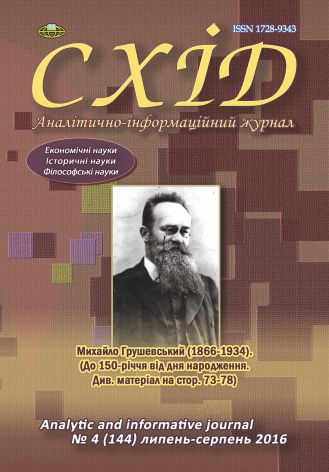Female elements in figuratively symbolic ideas of Slavic mythology
DOI:
https://doi.org/10.21847/1728-9343.2016.4(144).78202Keywords:
myth, cult, woman, archetype, symbolsAbstract
In article it is proved that in the life of the Slavic peoples the special place held by a woman. "Female" cults and beliefs reflected in figurative and symbolic representations of Slavic mythology. It recorded the stereotypes, archetypes and symbols which are then in an ancient society has formed certain social attitudes and cultural canons. Figuratively symbolic representations in different cultures became the basis of the IN social constructs of identity related cultures. Figuratively, a symbolic representation of Slavic mythology testify to the woman's place in society, her position in the family, relationship with man and environment.
History mythology gives the opportunity to see the unity of the human mind (consciousness) and divine soul (the unconscious (according to Jung) of man and nature. But the emergence of Archetypal images is partly determined by the individual typological structure of human identity.
Already in ancient mythology was formed the cult of Woman, which for thousands of years, embodies the ambivalence of perception: the magic authority of feminity, wisdom and spiritual growth, extending beyond formal logic, any helpful instinct or impulse all that is called kindness, which gives care and support, contributes to the development and productiveness of, contrasted with secret hidden dark: the abyss, the world of the dead, all that devours, seduces and poisons, everything that causes terror and is inevitable as fate itself. Ancient women's cults of the Slavs was a holistic cultural-ideological system, appears part of a wider system of mythological ideas of the peoples of Europe.
Women's cults of the peoples of Eastern and Western Slavs belong to the related cultures. Slavic mythological images are close to the mythological images of the other peoples of Europe (particularly the Celts and Greeks), however, have their identity associated with the allocation of the total Indo-European family, at a certain stage of development of ethnos.
The analysis of figurative and symbolic representations of Slavic mythology suggests that actualizes the problem of incorporating a "women's cults" gender and strain family relations.
Downloads
References
Markov, D.E. (2014), The keeper of the throne and the country: sacral-political aspect of worship in Nepal Taleju, Shodoznavstvo, № 68, 77-95 (rus).
Kruglikova, I.T. (1966), About the cult of the supreme feminine deity in the Bosporusin II-III, in: Culture of the Ancient World. The fortieth anniversary of the scientific work of Vladimir Dmitrievich Blavatsky - his friends, fellow disciples, W.p., Moscow, 110-115 (rus).
Rusyaeva, A. (1972), Cult of Cybele in Olbia, Archaeology, № 2, Kyiv, 35-45 (rus).
Eliade, M.(2001), Sacred and the profane; Myths, dreams and mysteries; Mephistopheles and androgynous; Occultism, witchcraft and cultural preferences [travslat.], Salome Pavlichko Publisher «Osnovy», Kyiv, 591 p. (ukr).
Lozko, G. (1996), The problem of the original substrate, in: Small encyclopedia etnoderzhavoznavstva, Kyiv, 131 (ukr).
Encyclopedia of mythology, available at: http://godsbay.ru.
Venger, O. M. (2013), gender component of humanistic management: theoretical and methodological aspects, Humanitarian Bulletin Zaporozhye State Engineering Academy, Zaporizhia, № 56, 92-101 (ukr).
Hrymych, M. (2000), Traditional outlook and constant ethnopsychological Ukrainian (cognitive anthropology), JSC «Vipol», Kyiv, 380 p. (ukr).
Strakhov, O.A. (1992), Folk spiritual culture and Christianity, Rodovid, № 4, 41-43 (ukr).
Chuhym, Natalia (2004), Problems of gender, origin and genesis, in: Basic theory of gender, «KIS» Publishing, Kyiv, 30-78 (ukr).
Voytovych, V. (2009), Myths and Legends of Ancient Ukraine, Educational book - Bogdan, Ternopil, 392 p. (ukr).
Halaychuk, V. (2008), Demonological population Middle Polissya idea of mermaids, Bulletin of Lviv University. Series: historical science, Vol. 43, 320-381 (ukr).
Lozko, G. (1995), Beliefs, mythology, demonology Ukrainian, Ukrainian ethnology, W.p., Kyiv, 113-139 (ukr).
Plachinda, S. (2008), As Ukrainian myths around the world diverged, Taki spravy publishing, Kyiv, 320 p. (ukr).
Plachinda, S. (1993), Dictionary of ancient mythology, Ukrainskyi pysmennyk, Kyiv, 63 p. (ukr).
Jung, Carl Gustav (1991), Archetypes symbol [translat.], Progress, Moscow, 85 p. (rus).
Jung, Carl Gustav (1997), On the question of the subconscious [translat.], in: A Man and His Symbols, «Silver yarn» Publishing, Moscow, p. 95 (rus).
Downloads
Published
How to Cite
Issue
Section
License
Copyright (c) 2016 Diana Chuvashova

This work is licensed under a Creative Commons Attribution-NonCommercial-NoDerivatives 4.0 International License.
1. Authors bear responsibility for the accuracy of facts, quotations, numbers and names used.
2. Manuscripts are not sent back.
3. The publisher does not always agree with the authors' opinion.
4. The authors reserve the right to authorship of the work and pass the first publication right of this work to the journal under the terms of a Creative Commons Attribution-NonCommercial-NoDerivatives 4.0 International License. This license allows others to distribute (copy) the published work for non-commercial purposes, provided there is mandatory attribution to its authors and a link to the first publication in our journal.
5. The authors have the right to conclude separate supplement agreements that relate to non-exclusive work distribution in the form in which it has been published by the journal (for example, to upload the work to the online storage of the journal or publish it as part of a monograph), provided that the reference to the first publication of the work in this journal is included.

